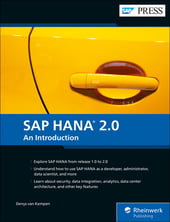If you're familiar with SAP HANA, you know that it's an in-memory database involving massive amounts of data.
It can be used, for example, to automate tasks quickly and easily. What you may not know is that SAP HANA also has powerful spatial capabilities, making it ideal for data science applications.
In this article, we'll explore how SAP HANA powers spatial data science in industries from education to transportation.
What is Spatial Data Science?
Spatial data science integrates traditional data science techniques with geographic information to answer questions about the real world. By understanding the relationships between location data and all the other information they care about, spatial data scientists can solve problems in a wide range of fields, from public health and transportation to logistics.
In recent years, cheaper sensors have made it possible to collect vast amounts of spatial data, and tools like machine learning are beginning to unlock that data's full potential. As the field continues to grow, spatial data science is set to make a huge impact on the way we live and work.
What Is SAP HANA?
SAP HANA is a business data platform that helps companies transform their businesses in the digital age. SAP HANA allows businesses to run real-time analysis and use predictive analytics to make better decisions. Additionally, SAP HANA provides a way for businesses to connect their data securely and easily across different platforms.
By using SAP HANA, businesses can become more agile and efficient. Think of it like continuous testing in software. What is continuous testing? It's a practice where software is rapidly and automatically tested at every stage of development. This means mistakes are caught as soon as possible and don't make it into production code.
Similarly, a sophisticated real-time data platform lets businesses monitor KPIs and course-correct as soon as they see something's not working. As the world increasingly moves towards digital transformation, SAP HANA will become an essential tool for businesses that want to stay ahead of the curve.
SAP HANA is different from other database management systems on the market today because it combines online analytical processing (OLAP) and online transactional processing (OLTP) and stores data in column-based tables in its memory. This means you can run powerful analytics and very fast transactions on the same system: the software isn't reaching into storage to query every new piece of data.
Why is that important? Because it enables businesses to query data instantly, analyze huge volumes of data with almost zero delays, and start making informed decisions about real-time data.
SAP HANA has become an industry standard since its introduction in 2010. But it's more than just a database. As well as acting as a database server that can store and retrieve data requested by applications, SAP HANA offers advanced search, visualization, and integration capabilities for all kinds of data, whether it's structured or unstructured.
It helps businesses develop intelligent, insight-driven apps by serving as an application server and using real-time data, in-memory processing, and machine learning technologies. These features are available on-site and in the cloud, which makes SAP HANA flexible for any business's requirements.
Some of SAP HANA's tools for data analysis include the following.
Data Transformation Services
You can convert data across formats using data transformation services, for example, JSON to CSV. Data transformation services also enable you to schedule data transformation tasks that can run automatically when new data has come in. This keeps your reports up to date no matter what format your data is coming in.
Data Access Services
You can access data in SAP HANA using data access services. Several functions are offered by these, like the ability to build and execute SQL queries, browse tables of data, and export that data to Microsoft Excel. This allows everyone in the company to access the data they need no matter their experience with SAP HANA.
Smart Data Integration
You can incorporate data from several diverse sources into SAP HANA using smart data integration. That could be anything from package deliveries, to supply chain data, to data mined using voice analytics. Smart data integration enables you to build connections between data points and synthesize them into coherent insights that can inform business decisions.
Smart Data Quality
You can use smart data quality to enrich your data automatically. This enables you to create rules for enriching data, see quality reports, and address highlighted issues with your data quality.
Data Services Management Console
You can manage your SAP HANA setup with the help of the data services management console. This easily handles routine work like adjusting your security settings, managing user accounts and permissions, and monitoring the performance of your system.
Powering Spatial Data Science with SAP HANA
With these features, spatial data scientists can run full-text and sophisticated fuzzy searches on vast amounts of data. Support for spatial data formats like Esri Grid and GeoTIFF is built in, and SAP HANA's graph data processing capabilities can be combined with text, predictive, spatial, document (JSON), and conventional relational data structures.
And using machine learning, streaming data may be stored, queried, and analyzed to find trends over time. This data could come from anywhere, from time-series-formatted sensors, industrial machinery, and Internet of Things (IoT) devices like smart appliances in the home or delivery vehicles.
Business intelligence and analytics tools use SAP HANA so you can get quick answers to queries about proximity, distance, and location, and then create detailed, geographically relevant insights in maps, reports, and charts. These integrations make data analytics as easy as any web-based collaboration tool your team uses every day.
These spatial analysis features help you identify hidden revenue opportunities within your business. You can make targeted, location-specific offers to customers and vendors, improve engagement and retention, and gain immediate insight about object locations to help you increase cross-sell and up-sell effectiveness. Location intelligence can also help you identify key product, store, employee, and equipment performance opportunities.
SAP HANA powers spatial data science in a wide variety of industries. In retail, it becomes easy to figure out where online customers are and use that information to visualize where new store locations would be most profitable. In aid and healthcare, providers can look at populations spread across rural areas and figure out how best to deploy their limited resources.
And in transportation and logistics, companies can map the most efficient routes and use their customers' locations to place new warehouses and dispatch centers. If it's an ecommerce company doing those deliveries, and they're using CCaaS in their contact center, they're able to make that data accessible to their customer service team who can give customers the most up-to-date information on their orders.
How to Use SAP HANA in Spatial Data Science
Any spatial data project with SAP HANA will follow something like this process.
Prepare
Geospatial data may be saved and accessed with SAP HANA just like any other sort of data. Geospatial data can be obtained from a variety of sources, including web services that make geographical data available and SAP HANA spatial models.
Once the data has been sourced from an SAP HANA model or an external web service, SAP HANA can convert it to JSON and prepare it for entry in its column-oriented memory. From there, it's ready to process.
Enhance
Raw spatial data is useless without some basic interpretation. That data will need to be correlated and labeled as representing real-world objects like vehicles or buildings before it can be worked on further.
Each spatial dataset will have the same basic properties: points, lines, and polygons. And SAP HANA can correlate those based on factors like the intersection of lines, the proximity of points, or whether whole objects and areas of interest are contained within others. These simple calculations are how you're able to turn raw data into meaningful objects you can start to analyze further.
Visualize & Generate Insight
SAP HANA's real-time capability means you can adjust your visualizations on the fly and see results instantly. This is good for discovering insights and making clear trends you might not have noticed if they were lost in a spreadsheet. And its powerful visualization tools let you output a final business report or live dashboard in whatever format is most appropriate.
Powering Spatial Data Science with SAP HANA
Spatial data science often uses a huge amount of data, and SAP HANA's real-time capability can make that data accessible to users and provide instant visualizations. As sensors get cheaper every year and IoT devices become more common, even across mobile networks, we're only going to see more spatial data science demand that requires powerful computing and analytics tools like SAP HANA.
This post was originally published 4/2023.




Comments